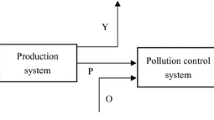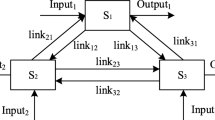Abstract
This paper constructs an Environmental Sustainability index in order to investigate regional efficiency in China between 2000 and 2012. The Environmental Sustainability index consists of a Production Efficiency index and an Eco-efficiency index. A multiplicative relational network data envelopment analysis model is applied, and a window analysis is conducted to capture the efficiency trends over time. The results reveal significant heterogeneity among Chinese provinces for the Environmental Sustainability and the Eco-efficiency indices, while there is a high level of Production Efficiency across all provinces. Furthermore, there are large differences among geographical areas. Specifically, high Production Efficiency levels are reported for the eastern area, whereas, high Eco-efficiency levels are reported for the western area. The reported results provide valuable insights to decision makers, revealing a high potential for improvement in the overall Environmental Sustainability score, especially for the eastern and middle areas. In addition, regional heterogeneity should be taken into account when considering new legislation.







Similar content being viewed by others
Notes
In this study, priority is given to the efficiency of the second stage because we primarily want to focus on the environmental intensity index and the relationship between economic production and environmental pollution.
There are four municipalities, including Beijing, Shanghai, Tianjin and Chongqing. Meanwhile, there are five autonomous regions, including Xinjiang, Tibet, Inner Mongolia, Guangxi and Ningxia. They all have the same the administrative status with other provinces.
Similar tables have been created for all Chinese provinces and are available upon request. Here we present only one due to space restrictions.
Bright green colour depicts the most efficient countries and red colour depicts the least efficient countries. The range among each class is 0.10 for all classes. Starting from the better classes in terms of efficiency scores they are classified as bright green, dark green, blue, light blue, turquoise, yellow, rose, pink, orange and red. The map is a visual representation of the regions were data is available, it does not represent China’s boarders and jurisdiction.
The eastern area includes the eight coastal provinces, Liaoning, Hebei, Shandong, Jiangsu, Zhejiang, Fujian, Guangdong and Hainan, and the three municipalities of Beijing, Tianjin and Shanghai. The middle area consists of 10 inland provinces, Heilongjiang, Jilin, Inner Mongolia, Henan, Shanxi, Anhui, Hubei, Hunan, Jiangxi and Guangxi, it is the agricultural base for the country. The western area contains 1 municipality and 9 provinces, Chongqing and provinces of Gansu, Guizhou, Ningxia, Qinghai, Shaanxi, Tibet, Yunnan, Xinjiang and Sichuan.
According to the Air Pollution Prevention and Control Law, the government decided to restrict the SO2 emissions in some provinces since 1998, including Beijing, Tianjin, Hebei, Jilin, Liaoning, Inner Mongolia, Shandong, Jiangsu, Henan, Shaanxi, Gansu, Ningxia and Xinjiang. As the regulation on carbon emission has not launched until the beginning of twenty-first century.
References
Aparicio J, Kapelko M, Ortiz L (2019) Modelling environmental inefficiency under a quota system. Oper Res. https://doi.org/10.1007/s12351-019-00487-z
Asmild M, Paradi JC, Aggarwall V, Schaffnit C (2004) Combining DEA window analysis with the Malmquist index approach in a study of the Canadian banking industry. J Product Anal 21:67–89
Avkiran N (1999) An application reference for data envelopment analysis in branch banking: helping the novice researcher. Int J Bank Marke 17:206–220
Brundtland GH (1987) Our common future. World Commission on Environment and Development, United Nations. www.undocuments.net/our-common-future.pdf
Chao C-W, Ma H-W, Heijungs R (2013) The green economy mirage? Examining the environmental implications of low carbon growth plans in Taiwan. J Ind Ecol 17:835–845
Charnes A, Cooper WW (1962) Programming with linear fractional functionals. Naval Res Logist Quart 9(3–4):181–186
Charnes A, Cooper WW (1984) Preface to topics in data envelopment analysis. Ann Oper Res 2(1):59–94
Charnes A, Cooper WW, Seiford LM (1994) Extension to DEA models. In: Charnes A, Cooper WW, Lewin AY, Seiford LM (eds) Data envelopment analysis: theory, methodology and applications. Kluwer Academic Publishers, Norwell
Chen Y, Cook WD, Li N, Zhu J (2009) Additive efficiency decomposition in two-stage DEA. Eur J Oper Res 196(3):1170–1176
Chen Y, Ebenstein A, Greenstone M, Li H (2013) Evidence on the impact of sustained exposure to air pollution on life expectancy from China’s Huai River policy. Proc Nat Acad Sci 110(32):12936–12941
Chen Z, Barros CP, Gil-Alana LA (2016) The persistence of air pollution in four mega-cities of China. Habitat Int 56:103–108
Choi Y, Lee EY (2009) Optimizing risk management for the sustainable performance of the regional innovation system in Korea through meta-mediation. Hum Ecol Risk Assess 15:270–280
Chu J, Wu J, Zhu Q, An Q, Xiong B (2016) Analysis of China’s regional eco-efficiency: a DEA two-stage network approach with equitable efficiency decomposition. Comput Econ. https://doi.org/10.1007/s10614-015-9558-8
Dyson RG, Allen R, Camanho AS, Podinovski VV, Sarrico CS, Shale EA (2001) Pitfalls and protocols in DEA. Eur J Oper Res 132:245–259
Färe R, Grosskopf S (1996) Intertemporal production frontiers: with dynamic DEA. Kluwer Academic Publishers, Boston
Färe R, Grosskopf S (2003) Non-parametric productivity analysis with undesirable outputs: comment. Am J Agric Econ 85:1070–1074
Färe R, Grosskopf S (2004) Modeling undesirable factors in efficiency evaluation: comment. Eur J Oper Res 157(1):242–245
Flamos A, Anagnostopoulos K, Doukas H, Goletsis Y, Psarras J (2004) Application of the IDEA-AM (Integrated Development and Environmental Additionality — Assessment Methodology) to compare 12 real projects from the Mediterranean region. Oper Res Int J 4(2):119–145
Førsund FR (2009) Good modelling of bad outputs: pollution and multiple-output production. Int Rev Environ Resour Econ 3:1–38
Hailu A, Veeman TS (2001) Non-parametric productivity analysis with undesirable outputs: an application to the Canadian pulp and paper industry. Am J Agric Econ 83(3):605–616
Hampf B (2018) Measuring inefficiency in the presence of bad outputs: does the disposability assumption matter? Empir Econ 54(1):101–127
Huang J, Yang X, Cheng G, Wang S (2014) A comprehensive eco-efficiency model and dynamics of regional eco-efficiency in China. J Clean Prod 67:228–238
Huppes G, Ishikawa M (2005) Eco-efficiency and its terminology. J Ind Ecol 9(4):43–46
Huppes G, Ishikawa M (2011) Visions for industrial ecology: preface to the special edition. J Ind Ecol 15:641–642
Kao C, Hwang S-N (2008) Efficiency decomposition in two-stage data envelopment analysis: an application to non-life insurance companies in Taiwan. Eur J Oper Res 185:418–429
Kao C, Hwang S-N (2010) Efficiency measurement for network systems: IT impact on firm performance. Decis Support Syst 48:437–446
Kao C, Liu S-T (2014) Multi-period efficiency measurement in data envelopment analysis: the case of Taiwanese commercial banks. Omega 47:90–98
Kuosmanen T (2005) Weak disposability in nonparametric production analysis with undesirable outputs. Am J Agric Econ 87(4):1077–1082
Kuosmanen T, Kortelainen M (2005) Measuring eco-efficiency of production with data envelopment analysis. J Ind Ecol 9(4):59–72
Li LB, Hu JL (2012) Ecological total-factor energy efficiency of regions in China. Energy Policy 46:216–224
Lovell CAK, Pastor JT, Turner JA (1995) Measuring macroeconomic performance in the OECD: a comparison of European and non-European countries. Eur J Oper Res 87(3):507–518
Lu Z, Wang H, Yue Q (2015) Decoupling analysis of the environmental mountain: with case studies from China. J Ind Ecol 19:1082–1090
Mostafa MM (2009) Modeling the efficiency of top Arab banks: a DEA–neural network approach. Expert Syst Appl 36:309–320
National Bureau of Statistics of China (2013a) China Statistical Yearbook 2013. China Statistics Press, China
National Bureau of Statistics of China (2013b) China Energy Statistics Yearbook 2013. China Statistics Press, China
National Bureau of Statistics of China (2014) China Environment Statistical Yearbook 2013. China Statistics Press, China
Olivier JGJ, Schure KM, Peters JAHW (2017) Trends in global CO2 and total greenhouse gas emissions: 2017 report. PBL Netherlands Environmental Assessment Agency, The Hague
Pastor JT, Asmild M, Lovell CK (2011) The biennial Malmquist productivity change index. Socio Econ Plan Sci 45(1):10–15
Peng C, Wu X, Fu Y, Lai KK (2017) Alternative approaches to constructing composite indicators: an application to construct a Sustainable Energy Index for APEC economies. Oper Res Int J 17(3):747–759
Ren S, Li X, Yuan B, Li D, Chen X (2016) The effects of three types of environmental regulation on eco-efficiency: a cross-region analysis in China. J Clean Prod 173(1):245–255
Scheel H (2001) Undesirable outputs in efficiency valuations. Eur J Oper Res 132:400–410
Seiford LM, Zhu J (2002) Modeling undesirable factors in efficiency evaluation. Eur J Oper Res 142(1):16–20
Seiford LM, Zhu J (2005) A response to comments on modeling undesirable factors in efficiency evaluation. Eur J Oper Res 161(2):579–581
Shephard RW (1970) Theory of cost and production functions. Princeton University Press, Princeton
Siriopoulos C, Tziogkidis P (2010) How do Greek banking institutions react after significant events? A DEA approach. Omega 38(5):294–308
Song M-L, Zhou Y-X, Zhang R-R, Fisher R (2017) Environmental efficiency evaluation with left–right fuzzy numbers. Oper Res Int J 17(3):697–714
Tanaka S (2015) Environmental regulations on air pollution in China and their impact on infant mortality. J Health Econ 42:90–103
Thanassoulis E, Kortelainen M, Johnes G, Johnes J (2011) Costs and efficiency of higher education institutions in England: a DEA analysis. J Oper Res Soc 62(7):1282–1297
Tsolas IE (2015) Firm credit risk evaluation: a series two-stage DEA modeling framework. Ann Oper Res 233:483–500
Tsolas IE, Charles V (2015) Incorporating risk into bank efficiency: a satisficing DEA approach to assess the Greek banking crisis. Expert Syst Appl 42(7):3491–3500
Wang Y-M, Chin K-S (2010) Some alternative DEA models for two-stage process. Expert Syst Appl 37:8799–8808
Wang K, Yu S, Zhang W (2013a) China’s regional energy and environmental efficiency: a DEA window analysis based dynamic evaluation. Math Comput Model 58:1117–1127
Wang K, Wei YM, Zhang X (2013b) Energy and emissions efficiency patterns of Chinese regions: a multi-directional efficiency analysis. Appl Energy 104:105–116
Wang K, Lu B, Wei YM (2013c) China’s regional energy and environmental efficiency: a range-adjusted measure based analysis. Appl Energy 112:1403–1415
Wang K, Mi Z, Wei Y-M (2018) Will pollution taxes improve joint ecological and economic efficiency of thermal power industry in China? A DEA-based materials balance approach. J Ind Ecol 23:389–401
Wu J, Zhu Q, Yin P, Song M (2017) Measuring energy and environmental performance for regions in China by using DEA-based Malmquist indices. Oper Res Int J 17(3):715–735
Wursthorn S, Poganietz W-R, Schebek L (2011) Economic environmental monitoring indicators for European countries: a disaggregated sector-based approach for monitoring eco-efficiency. Ecol Econ 70(3):487–496
Yang L, Zhang X (2018) Assessing regional eco-efficiency from the perspective of resource, environmental and economic performance in China: a bootstrapping approach in global data envelopment analysis. J Clean Prod 173:100–111
Yang L, Ouyang H, Fang K, Ye L, Zhang J (2015) Evaluation of regional environmental efficiencies in China based on super-efficiency-DEA. Ecol Indic 51:13–19
Yu Y, Choi Y (2015) Measuring environmental performance under regional heterogeneity in China: a metafrontier efficiency analysis. Comput Econ 46(3):375–388
Zaim O (2004) Measuring environmental performance of state manufacturing through changes in pollution intensities: a DEA framework. Ecol Econ 48(1):37–47
Zhang N, Chen Z (2017) Sustainability characteristics of China’s Poyang Lake Eco-Economics Zone in the big data environment. J Clean Prod 142:642–653
Zhang B, Bi J, Fan Z, Yuan Z, Ge J (2008) Eco-efficiency analysis of industrial system in China: a data envelopment analysis approach. Ecol Econ 68(1–2):306–316
Zhang J, Zeng W, Shi H (2016) Regional environmental efficiency in China: analysis based on a regional slack-based measure with environmental undesirable outputs. Ecol Indic 71:218–228
Author information
Authors and Affiliations
Corresponding author
Additional information
Publisher's Note
Springer Nature remains neutral with regard to jurisdictional claims in published maps and institutional affiliations.
Rights and permissions
About this article
Cite this article
Chen, Z., Kourtzidis, S., Tzeremes, P. et al. A robust network DEA model for sustainability assessment: an application to Chinese Provinces. Oper Res Int J 22, 235–262 (2022). https://doi.org/10.1007/s12351-020-00553-x
Received:
Revised:
Accepted:
Published:
Issue Date:
DOI: https://doi.org/10.1007/s12351-020-00553-x
Keywords
- Chinese provinces
- Eco-efficiency
- Environmental sustainability
- Network data envelopment analysis
- Production efficiency




